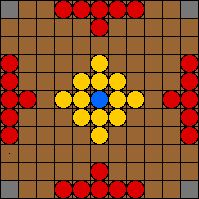Throw Board

Throw board was first mentioned around 914 to 943 in lore, but was finally describe, and last record of play in Wales, in 1587. R.C. Bell included this game in his book Board and Table Games from Many Civilizations. Unlike his book, the board layout is his historical record where Bell's lay out violates the "undefended file" rule of the Tafl game construction. Bell also believes that dice where used to determine if a player could move, but this rule is not necessary. This game was also found around York, England, where the local museum has made a reproduction of this game. Sadly, this copy of the game as of this writing is only available in Europe. The editor was able to pick up a copy of this game while visiting the Viking Ship Museum in Oslo. Some of the rules differ from the authors version of the game and the museum copy, and will be so noted in the rules. The rules that follow reflect the way it may have been played in the ninth and tenth centuries.
The rule to Throw Board goes as such:
1) The board is set up as shown. the King's forces move first and then alternating thereafter.
2) Any piece may move any number of vacant spaces in a straight line or thagonally.
3) A piece is captured if opposing two opposing pieces are moved onto adjacent spaces on either side of it. Once this is done, the piece is captured and removed from the board.
4) Any piece may pass between two opposing pieces, as long as that piece does not stop between them. if it does stop between them, it is captured and removed from the game.
5) The King is the only piece that may come to a stop between two enemy pieces. But to do so, the player must announce "Resting" before placing the King there.
6) The King's forces win if the King reaches any edge of the board, and loses if the King is captured.
Variations to the game:
1) No piece may occupy the throne (center space) except the King. Other pieces may pass over it freely, but can not rest on that spot.
2) Only the King may move onto the corner spaces, no other piece may rest, or pass over it.
3) A piece may be captured if on one side is the corner space and the other side is an enemy piece. The space will act as the other enemy piece.
4) The King must be captured on four sides, or three sides and the throne acting as a fourth piece.
5) For the King 's forces to win, the King must reach one of the corner spaces.

 Tweet
Tweet
 Copyright© 2013 Viking Age Club
Copyright© 2013 Viking Age Club